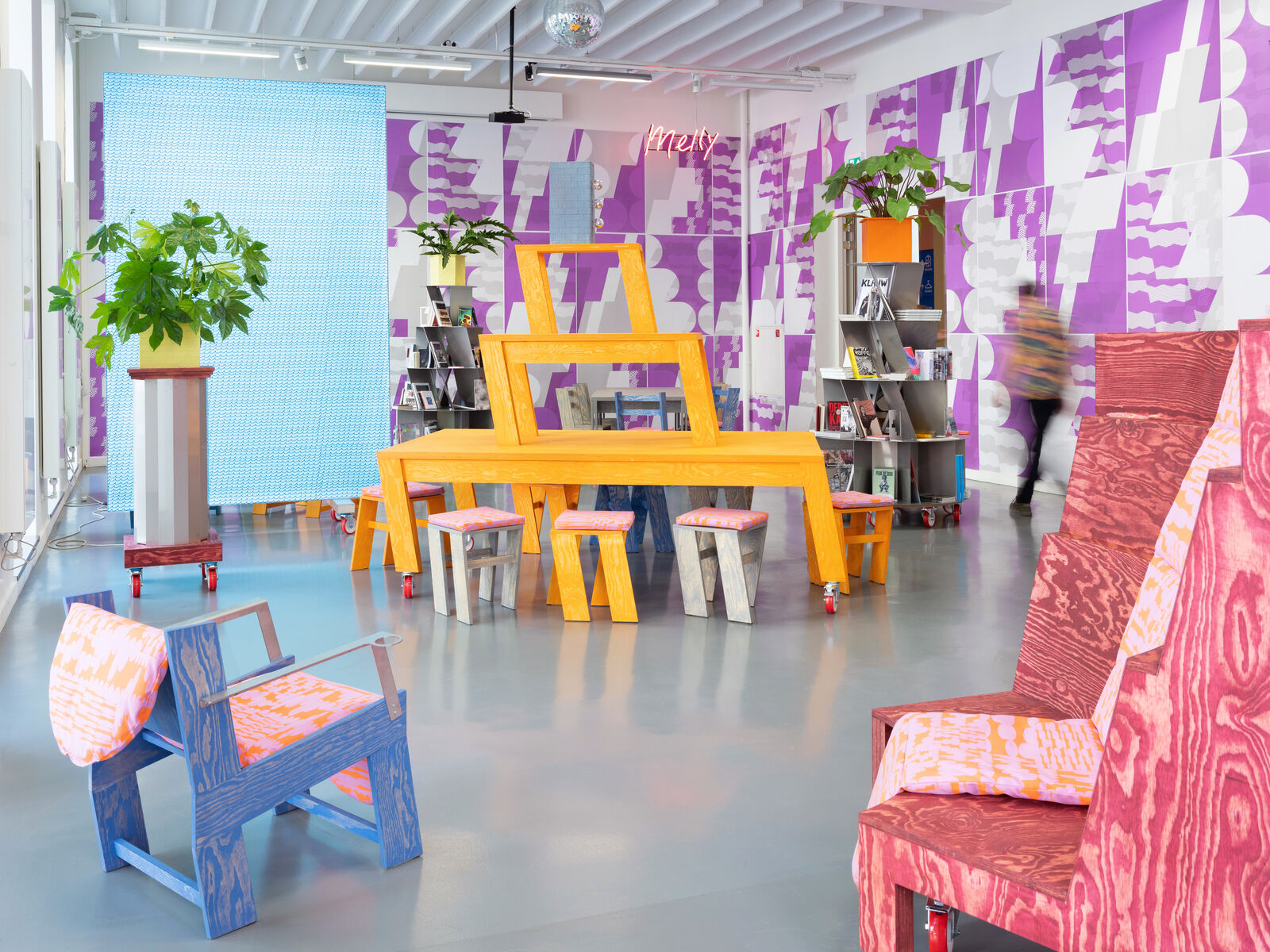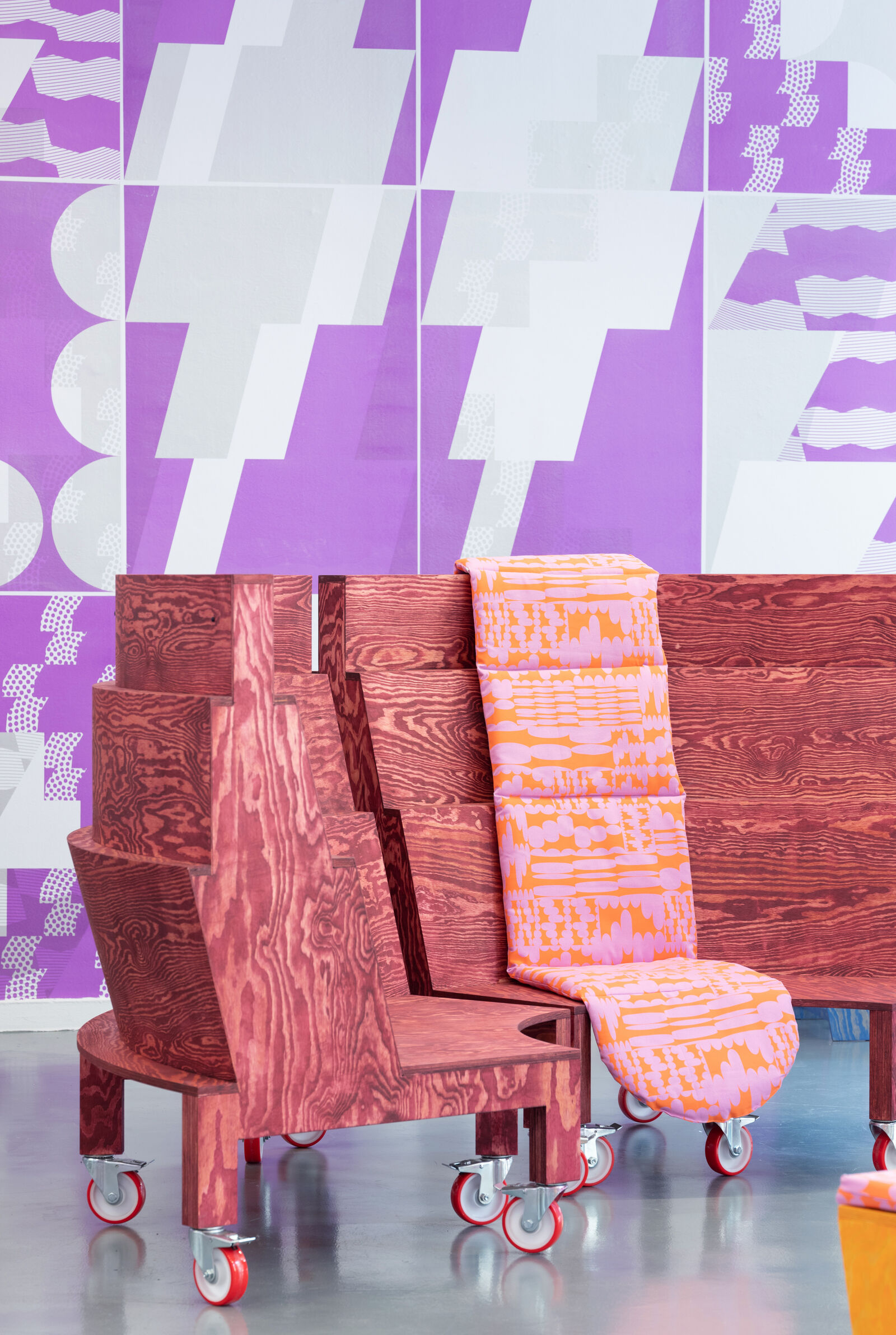A new artistic environment in MELLY by Loes van Esch and Simone Trum from the graphic-design studio known as Team Thursday, architect Tomas Dirrix, and artist Koen Taselaar
An interdisciplinary group of Rotterdam makers—including Tomas Dirrix, Loes van Esch, Koen Taselaar and Simone Trum—create a new artistic environment for MELLY. MELLY is admission-free, and open to the general public during Kunstinstituut Melly’s regular gallery hours: Wednesdays through Sundays from 11 am to 6 pm, and Fridays until 9 pm, as part of Kunstavond.
Developed in 2018 as a curatorial project at the intersection of art and education, MELLY is Kunstinstituut Melly’s ground-floor gallery turned multipurpose space. Here, numerous artists have created new work, whether hung on the walls, displayed in vitrines, presented live, or a combination of all the above. Here, too, numerous activities and public programs take place year-round. MELLY’s creation came together with the institution’s work-learn project, called Collective Learning in Practice a.k.a. CLIP, which is now in its fifth annual edition. The space also includes a cafe plus a bookshop, which carries publications related to Kunstinstituut Melly’s exhibitions and programs, as well as CBK’s selection of titles, with a special focus on books made by Rotterdam artists.
Working collaboratively, Dirrix, Van Esch, Taselaar, and Trum, reflected on MELLY as not just a place to experience art; it is often a space used to rehearse ideas and to perform publicly. Considering this, they envisioned that the various elements they would create for MELLY could be conceived of as a dance troupe. The shared trait of their design pieces is that these can be easily re-arranged to serve as either a bookshop and cafe lounge, as well as to conduct a workshop, accommodate a lecture, or convene a meeting or even a dance itself. (Speakers and a disco ball already hung in MELLY; removing these was the only thing they were not allowed to do.) In this sense, the environment can host different scores and perform various kinds of functions.
Among the new elements for the space designed by the Rotterdam makers is a rectangular aluminum frame, which is three-meter-tall and sits on wheels. This mobile piece can glide through the space, and be used in different manners: at times, as a floor lamp; at other times, as a lightbox for an artwork or signage; sometimes, perhaps as a room divider, as a structure to hold a backdrop, or in any other imaginable way.
The environment by Dirrix, Van Esch, Taselaar, and Trum also includes textile and silkscreened paper designs. The latter is pasted on most walls within MELLY. In both their form and content, these are partly inspired by a sense of interconnectivity communicated by bodies and their shadows in movement, specifically by a choreographic score of Anne Teresa de Keersmaeker. These silkscreens also appear to bring the bustle of public space inside. The entire space—and whenever there’s programming, its activities, attendance, and spirit—can be seen through the large windows on MELLY’s main perimeter walls, which are lined to the street.
A distinctive element in the new environment created by the Rotterdam makers is a trio of cone-shaped bookshelves, a design that could well refer to pompous crinolines, a Bauhaus stage costume, or the architectural centerpiece in Pieter Bruegel’s Tower of Babel. With a ludic approach, these bookshelves, co-designed with Phil Proctor, are equipped with wheels and topped with plants. So are some layered tables and seating they’ve made for MELLY. And while not all their chairs for the space include a set of wheels, their lightness, and slanted shapes do inspire movement. Or play? Or drunkenness?
These pieces also recall archival photography showing the uses of Kunstinstituut Melly during the late nineteenth and early-twentieth centuries. Those images picture a group of women in different modalities, from studying to dancing to posing with geometric models (including a prominent cone) in what appears to be a drawing class. Built in the 1870s, Kunstinstituut Melly’s building was originally designed as a school; at present, this institution devoted to the art and theory of our present insists it is a site of learning.
Since MELLY has focused on the art of our present and in public engagement, the space and its various elements had to be versatile. For this reason, ensuring collaborative work and a sense of dynamism was a guiding principle for this artistic commission. MELLY’s new environment created by Dirrix, Van Esch, Taselaar, and Trum is part of the institution’s initiative Tools for Conviviality, promoting the creation of brave and safe art spaces that are functional, experimental, and inspiring. An earlier iteration of this initiative is the long-term and slowly-evolving group exhibition 84 STEPS, begun in 2021 and sited in Kunstinstituut Melly’s third-floor gallery; the title itself refers to the number of steps in the stairwell connecting MELLY on the ground-floor to Kunstinstituut Melly’s top-floor gallery.
This summer, Kunstinstituut Melly also convenes at its venue her network partners in Tools for Demodernizing, a program to develop a toolbox for making meaningful transformations in the arts sector. This program, as well as the exhibition-oriented strategy Tools for Conviviality and the recent publication Tools for Collective Learning, have been developed by Kunstinstituut Melly as part of its Name Change Initiative. Such a multifaceted initiative came with the promises to rename the institution (it was formerly known as Witte de With Center for Contemporary Art), as well as to make structural change. Without a doubt, these initiatives, including the co-creation modus operandi of CLIP, have been instrumental in diversifying the institution’s personnel, public, and program over the past five years.
The new artistic environment by Dirrix, Van Esch, Taselaar, and Trum is the first commission for MELLY since the summer of 2020. It replaces a floor- and wallpaper design featuring monochromes and color-gradient shapes, their hue inspired by the light signage at Kruiskade, a local street lined by cafes and shops reflective of Rotterdam’s cultural diversity. That design was created in Spring 2020 by Enchilada, a Rotterdam communication firm, and it indicated the social-distancing measure required during the Covid pandemic. Beforehand, MELLY’s space featured a group exhibition involving poster commissions to 12 artists from the region, celebrating the renaming of that gallery space, which was once called Untitled. During the year-long Untitled name period, the space featured a room-size painting commissioned to artist Federico Herrero. The core furniture used in the space since 2018, which was made by graphic designer Manuel Raeder, is replaced June 2023 with pieces designed as part of Dirrix, Van Esch, Taselaar, and Trum’s new environment for MELLY.
Following the collaboration for MELLY, Koen Taselaar has created a special limited edition commissioned by Kunstinstituut Melly. See here for more information.




